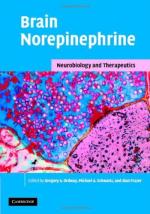|
This section contains 222 words (approx. 1 page at 300 words per page) |
Also referred to as adrenaline, it is a catecholamine NEUROTRANSMITTER known to be involved in the action of some addicting drugs. It is the biochemical product of DOPAMINE and the enzyme dopamine-beta-hydroxylase. It is the major neurotransmitter for the sympathetic nervous system, as well as for several sets of long axon, multiple-branched neurons (nerve cells) of the central nervous system. After release from nerve terminals onto its RECEPTORS, much of it is recaptured or removed from extracellular spaces by an uptake mechanism, or TRANSPORTER, located in the nerve terminal membrane. This transporter is an important drug target for antidepressants and psychostimulants. Monoamine oxidase is a well-known enzyme that breaks down norepinephrine.
Norepinephrine holds an important place in the history of drug studies. It was discovered as an active chemical in the body many years ago. The availability of pharmacological agonists and antagonists helped reveal its physiologic role in the body. Also the development of histochemical methods in the 1960s and 1970s for its direct light microscopic visualization led to a detailed understanding of the many neurons that contain it. Noradrenergic receptors, termed alpha and beta, can act independently or synergistically to mediate the activity of norepinephrine and related drugs. Brain noradrenergic neurons in the nucleus locus ceruleus are well characterized in general and are activated during withdrawal from addictive drugs.
|
This section contains 222 words (approx. 1 page at 300 words per page) |


